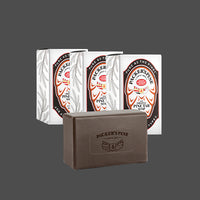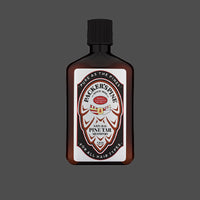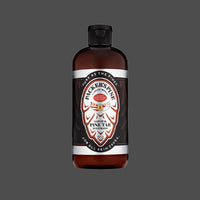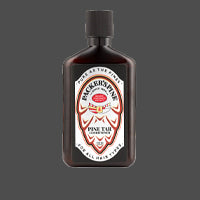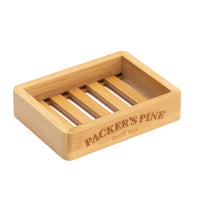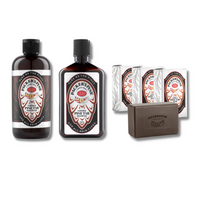Anti-fungal Pine Tar Soap
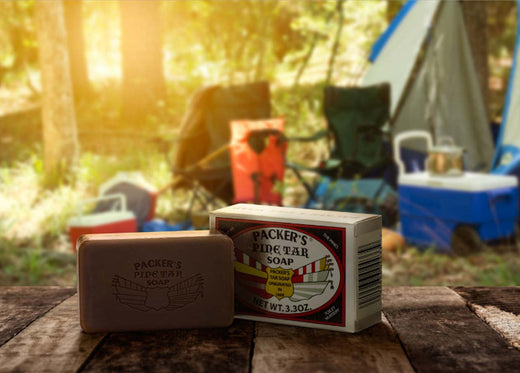
Fungal infections are some of the most stubborn types of infections to get rid of. Some of them are contagious and can be picked up in locker rooms and other high traffic areas. Some of them are caused by exposure, while the deeper, internal infections can be caused by gut dysbiosis or factors that are not so easy to eradicate. On top of all of that, fungi are good at outsmarting anti-fungal medications, so a cream or oral treatment that worked at first may not work after a few months.
How can you give your skin an advantage when opportunistic fungal infections could be lurking just about anywhere? Pine tar, the main active ingredient in Packer’s pine tar soap, has many natural qualities that may be protective against itching, bacteria, fungus, and even the replication of diseased cells that leads to conditions such as psoriasis. Anti-fungal pine tar soap should be used daily on fungal skin infections to prevent itching, soothe inflammation, and promote a return to normal keratinization. And it can do its job without stripping the skin of the vital protective oils that are necessary to skin health and elasticity.
What is a Fungal Infection?
Our bodies are host to an estimated 39 trillion cells that include a wide variety of bacteria, fungi, and other microorganisms. These live in our gut, hair, nails, on the surface of the skin, in the mouth, and around the genitals. Many of these are necessary to our bodily functions. However, some can become harmful when they are disturbed from their normal balance.
Fungi live in the air, water, on plants…basically, they are everywhere. Fungi reproduce by sending spores out into the world in hopes that they will land in a place where they can easily replicate.
Some fungal infections can be passed from one person to another, or from an animal or contaminated soil to a human.
Risk Factors for Developing a Fungal Infection
Everyone who encounters a fungal spore does not develop a fungal infection, which means that there must be other factors that determine who is and isn’t susceptible.
Fungal rashes tend to develop in areas of the body that are difficult to keep dry, such as the genital area, underarms, and inside the mouth. Babies may also develop fungal infections on skin that is exposed to diapers. Areas that are subject to sweaty conditions, as in athlete’s foot, tend to breed fungal infections.
Those with weakened immune systems may be particularly susceptible to fungal infections. Cancer patients taking chemotherapy and HIV/AIDS patients may develop complications from persistent fungal infections. Those with lupus, Crohn’s disease and ulcerative colitis, psoriasis and psoriatic arthritis, multiple sclerosis, and other autoimmune conditions are far more susceptible to fungal infections as well. On the other hand, one of the most common fungal infections, athlete’s foot, regularly affects those who are otherwise healthy.
Obesity is a factor, in large part because it causes skin folds that rub and chafe and collect moisture. Diabetes is another common risk factor for developing fungal infections because high blood sugar feeds yeast, potentially causing yeast infections in the mouth, vagina, gastrointestinal tract, and skin.
Long-term use of antibiotics can negatively affect gut bacteria, causing the microbiome to become unbalanced and leaving the body susceptible to overgrowth of fungi that can become extremely difficult to eradicate. The hormonal changes in pregnancy may also lead to fungal overgrowth.
Because human cells and fungi share much of the same basic structure and many of the same components, developing effective anti-fungal drugs can be a challenge, and fungi are good at outsmarting the ones that are available.
Treating Fungal Skin Infections
It’s important to address the cause(s) of the fungal infection; suppression of symptoms will likely only lead to the infection returning with a vengeance, and it may become resistant to medications and treatments that had a temporary positive effect.
If a rash has been caused by excess moisture and chafing alone, then wearing natural, breathable fabrics, using powder, and exposing skin to the air and sun should help to control the infection. Similarly, losing weight will help to eliminate skin folds where fungi can lodge and replicate.
Prescription drugs are available that have inconsistent results in treating fungal infections. Medicated creams and powders may be effective against superficial fungal infections, while internal medications may be required for infections in the mouth, throat, and vagina.
Using antifungal pine tar soap in the shower or bath every day is a good way to improve the impact of any other antifungal treatments you may be using.
Types of Fungal Skin Infections
Athlete’s foot—Athlete’s foot, or tinea pedis, is one of the most common fungal infections. It is estimated to affect as much as 20 to 25 percent of the world’s population at any given time. Athlete’s foot is caused by an overgrowth of the dermatophytes fungi, which can easily grow out of control in the warm, moist environment of your socks and athletic shoes. It causes burning, peeling, blisters, itching, and stinging between the toes or on the heels.
Ringworm—Caused by a fungus rather than a worm, ringworm expresses as a scaly, itchy rash that has a dark outer ring. The center of the ring is flaky and develops weeping blisters. Ringworm can also appear on the scalp or even as a nail infection.
Yeast Infections—Overgrowth of candida albicans fungus can cause various infections around the body. In the mouth, it causes oral thrush, which consists of white lesions that affect the tongue, inner cheeks, and gums, and causes burning and soreness. Oral thrush is most common in babies, breastfeeding mothers, and adults who wear dentures. In women, candida yeast causes vaginal yeast infections, which cause severe itch, inflammation, white vaginal discharge, redness, and swelling. Candida can affect the toenails and fingernails as well.
Jock Itch—Jock itch, or tinea cruris, is a fungal infection that mainly affects men around the groin, thighs, and buttocks and is caused by the same fungus that causes athlete’s foot. Symptoms include burning, itching, redness or a change in skin color, and a scaly, ringed, bumpy rash. The friction and the moist environment caused by exercise can make athlete’s foot worse.
The Components of Anti-fungal Pine Tar Soap
The main components of pine tar are surprisingly powerful. After all, pine tar is simply the result of heating pine wood to extremely high temperatures and collecting the sappy resin that results. The application of heat creates a reaction that brings out a wide array of compounds that have an anti-pruritic (or anti-itch), antiseptic, anti-inflammatory, and anti-fungal effect on skin and skin conditions.
You may recognize the names of some of the compounds that result from the heating process. For instance, turpentine is a result of the simple process of applying very high heat to wood. While most people would not consider putting turpentine on their skin, when it is in a natural, synergistic relationship with the rest of the components of pine tar, it is a powerful antiseptic and anti-fungal agent. The same goes for phenol, or carbolic acid. On its own, it is irritating and potentially toxic to skin and your internal workings (if ingested). However, in its natural state in pine tar, it acts as an effective disinfectant and fungicide.
Studies have shown that anti-fungal pine tar soap has few to no side effects and can safely be used daily, even on facial skin. Note that creosote, a byproduct of the heating process, has been completely removed from all Packer’s Pine products. Creosote has been identified as being potentially carcinogenic to humans.
How to Use Anti-fungal Pine Tar Soap
It is a good idea to get in the habit of using anti-fungal pine tar soap on a daily basis. Because of its anti-fungal action, lathering up with pine tar soap every day may help to inhibit the growth of fungi that could otherwise take hold when defenses are low.
Pine tar soap can be used as any other soap. Its lather is a result of naturally occurring substances in pine tar—not the synthetic chemicals, such as sodium lauryl sulfate, used in mass market soaps. When using pine tar soap, you want to create as much lather as possible and allow it to sit on the skin for as long as possible. Our body wash can be used on a sponge or washcloth to create a similar effect, or it can be used in the bath to allow affected skin to soak for an extended period of time. For fungal infections affecting the scalp, our anti-fungal pine tar shampoo is highly effective and has the benefit of moisturizing the scalp while neutralizing harmful fungal overgrowth.
Keep a bar of Packer’s Pine Tar Soap or a bottle of our pine tar body wash in your gym bag or in the car so it’s readily available when you need it. Prevention is the name of the game when it comes to dealing with fungi!



